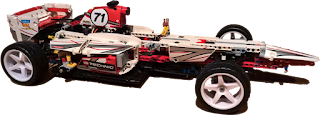So, there are several ways to solve this problem.
Requirement for all ways (with fixed shaft)
It is recommended that the engine shaft fits perfectly into the gear. I used an engine with an 3,7 mm shaft. This helps to align the gear.
If your shaft is thicker: Make it thinner ;)
If your shaft is thinner: Than it is new for me.
But I have there an idea. Drill a hole into an axle and glue your shaft into the axle. When someone has tried it, please tell us about your experience.
Glue it!
At the beginning, I only glued it with some hot glue. With this construction I created my first video of the 42000 model. But it can't transmit high torques and have problems with heat.
Slit and glue it!
First cut a slit of 5 mm or more into your shaft. Now take some metal which will fit into your slit and cut an rectangle which will fit into your slit, and a gear over both. Glue it now with hot glue.
Mount an axle!
Some engines have no fixed shaft like the Multistar BabyBeast. The shaft is only fixed with 4 screws.
This gives us the possibility to print our own shaft, which will fit to any LEGO gear. I have constructed this for an unreleased project. After an successful test, I will publish this .STL file too.








